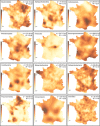Biogeography of soil bacteria and archaea across France
- PMID: 29978046
- PMCID: PMC6031370
- DOI: 10.1126/sciadv.aat1808
Biogeography of soil bacteria and archaea across France
Abstract
Over the last two decades, a considerable effort has been made to decipher the biogeography of soil microbial communities as a whole, from small to broad scales. In contrast, few studies have focused on the taxonomic groups constituting these communities; thus, our knowledge of their ecological attributes and the drivers determining their composition and distribution is limited. We applied a pyrosequencing approach targeting 16S ribosomal RNA (rRNA) genes in soil DNA to a set of 2173 soil samples from France to reach a comprehensive understanding of the spatial distribution of bacteria and archaea and to identify the ecological processes and environmental drivers involved. Taxonomic assignment of the soil 16S rRNA sequences indicated the presence of 32 bacterial phyla or subphyla and 3 archaeal phyla. Twenty of these 35 phyla were cosmopolitan and abundant, with heterogeneous spatial distributions structured in patches ranging from a 43- to 260-km radius. The hierarchy of the main environmental drivers of phyla distribution was soil pH > land management > soil texture > soil nutrients > climate. At a lower taxonomic level, 47 dominant genera belonging to 12 phyla aggregated 62.1% of the sequences. We also showed that the phylum-level distribution can be determined largely by the distribution of the dominant genus or, alternatively, reflect the combined distribution of all of the phylum members. Together, our study demonstrated that soil bacteria and archaea present highly diverse biogeographical patterns on a nationwide scale and that studies based on intensive and systematic sampling on a wide spatial scale provide a promising contribution for elucidating soil biodiversity determinism.
Figures






Similar articles
-
Contrasting spatial patterns and ecological attributes of soil bacterial and archaeal taxa across a landscape.Microbiologyopen. 2015 Jun;4(3):518-31. doi: 10.1002/mbo3.256. Epub 2015 Apr 28. Microbiologyopen. 2015. PMID: 25922908 Free PMC article.
-
Influence of land use on bacterial and archaeal diversity and community structures in three natural ecosystems and one agricultural soil.Arch Microbiol. 2017 Jul;199(5):711-721. doi: 10.1007/s00203-017-1347-4. Epub 2017 Feb 23. Arch Microbiol. 2017. PMID: 28233042
-
Microbial Diversity in an Arid, Naturally Saline Environment.Microb Ecol. 2019 Aug;78(2):494-505. doi: 10.1007/s00248-018-1301-2. Epub 2018 Dec 28. Microb Ecol. 2019. PMID: 30593603
-
Phylogenetic systematics of microorganisms inhabiting thermal environments.Biochemistry (Mosc). 2007 Dec;72(12):1299-312. doi: 10.1134/s0006297907120048. Biochemistry (Mosc). 2007. PMID: 18205614 Review.
-
The ecological coherence of high bacterial taxonomic ranks.Nat Rev Microbiol. 2010 Jul;8(7):523-9. doi: 10.1038/nrmicro2367. Nat Rev Microbiol. 2010. PMID: 20531276 Review.
Cited by
-
Phylogeography of the Bradyrhizobium spp. Associated With Peanut, Arachis hypogaea: Fellow Travelers or New Associations?Front Microbiol. 2019 Sep 4;10:2041. doi: 10.3389/fmicb.2019.02041. eCollection 2019. Front Microbiol. 2019. PMID: 31551977 Free PMC article.
-
The core bacteriobiome of Côte d'Ivoire soils across three vegetation zones.Front Microbiol. 2023 Aug 24;14:1220655. doi: 10.3389/fmicb.2023.1220655. eCollection 2023. Front Microbiol. 2023. PMID: 37692382 Free PMC article. Review.
-
Community assembly of comammox Nitrospira in coastal wetlands across southeastern China.Appl Environ Microbiol. 2023 Sep 28;89(9):e0080723. doi: 10.1128/aem.00807-23. Epub 2023 Sep 6. Appl Environ Microbiol. 2023. PMID: 37671870 Free PMC article.
-
Environmental tipping points for global soil nitrogen-fixing microorganisms.iScience. 2024 Dec 19;28(1):111634. doi: 10.1016/j.isci.2024.111634. eCollection 2025 Jan 17. iScience. 2024. PMID: 39850356 Free PMC article.
-
Site and land-use associations of soil bacteria and fungi define core and indicative taxa.FEMS Microbiol Ecol. 2022 Jan 7;97(12):fiab165. doi: 10.1093/femsec/fiab165. FEMS Microbiol Ecol. 2022. PMID: 34940884 Free PMC article.
References
-
- Griffiths R. I., Thomson B. C., Plassart P., Gweon H. S., Stone D., Creamer R. E., Lemanceau P., Bailey M. J., Mapping and validating predictions of soil bacterial biodiversity using European and national scale datasets. Appl. Soil Ecol. 97, 61–68 (2016).
-
- Karimi B., Maron P. A., Chemidlin Prévost-Bouré N., Bernard N., Gilbert D., Ranjard L., Microbial diversity and ecological networks as indicators of environmental quality. Environ. Chem. Lett. 15, 265–281 (2017).
-
- Griffiths R. I., Thomson B. C., James P., Bell T., Bailey M., Whiteley A. S., The bacterial biogeography of British soils. Environ. Microbiol. 13, 1642–1654 (2011). - PubMed
-
- Ranjard L., Dequiedt S., Chemidlin Prévost-Bouré N., Thioulouse J., Saby N. P. A., Lelievre M., Maron P. A., Morin F. E. R., Bispo A., Jolivet C., Arrouays D., Lemanceau P., Turnover of soil bacterial diversity driven by wide-scale environmental heterogeneity. Nat. Commun. 4, 1434 (2013). - PubMed
-
- Terrat S., Horrigue W., Dequiedt S., Saby N. P. A., Lelièvre M., Nowak V., Tripied J., Régnier T., Jolivet C., Arrouays D., Wincker P., Cruaud C., Karimi B., Bispo A., Maron P. A., Chemidlin Prévost-Bouré N., Ranjard L., Mapping and predictive variations of soil bacterial richness across France. PLOS ONE 12, e0186766 (2017). - PMC - PubMed
Publication types
MeSH terms
Substances
LinkOut - more resources
Full Text Sources
Other Literature Sources

